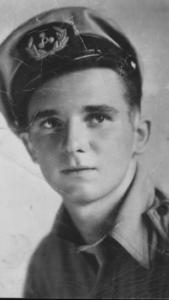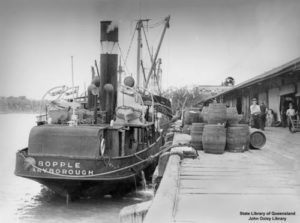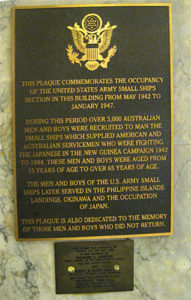- Author
- Editorial Staff
- Subjects
- Biographies and personal histories, WWII operations, History - WW2
- Tags
-
- RAN Ships
- None noted.
- Publication
- June 2021 edition of the Naval Historical Review (all rights reserved)
A recent photograph of some veterans at the 75th anniversary celebrations of the great Battles of Leyte Gulf showed Rear Admiral Guy Griffiths and ex-Able Seaman David Mattiske who both served in HMAS Shropshire. Proudly standing next to them was Leonard Roy Mcleod, whom we had not yet met, and this is his story. We wish to acknowledge the support provided by Mrs. Denise West, daughter of Len Mcleod, in providing information on her father’s story.
Leonard (Len) Roy Mcleod was born on 2 June 1926, a child of the Great Depression, the youngest of three children. His father, a WWI veteran, died of respiratory problems caused from gas attacks when serving in France, when Len was just five. So life was tough for Mum in the Melbourne working class suburb of Footscray. Len was a fine-looking young fellow who grew up quickly; at 15 he was nearly six feet tall. At the time he left school the war had started and with the excitement and fear of a Japanese invasion many young men were signing up in the armed services. Nearly all Len’s mates were in the Army.
Try, try and try again
Here Len showed initiative, a trait that was to remain with him through the rest of his life. He put his age up four years and in August 1941, using his mother’s maiden name, enlists as Leonard Roy Barlow VX67778 but after four months his true age is discovered and he is discharged. Not to be deterred, a few weeks later Len is back at the same Royal Park recruiting office and signs on again with an earlier birth date but this time under his own name Leonard Roy Mcleod VX59095. He tells Mum he has joined for cadet training but when she discovers he is about to go overseas she informs the authorities and again he is discharged.
It was to be third time lucky when Leonard Roy Mcleod became VX90340; perhaps by now Mum and the recruiting office were fed up with this willing volunteer. Len was accepted into the AIF and shortly afterwards found himself on a troop-train from Melbourne to Brisbane. He was amongst the first intake of Infantry at the new Army Combat Training Centre at Canungra in Southern Queensland, arriving on 3 December 1942. By the end of the month 218 trained men left Canungra bound for New Guinea. They started their journey from Brisbane taking the train to Townsville. From here they were flown as replacement troops to Port Moresby. On arriving at Murray Barracks they had their first taste of war as the town was being bombed by the Japanese.
When volunteers were called to assist the USAAF/RAAF in providing supplies to Army units in remote locations Len was amongst 18 men selected. The volunteers served in pairs allocated to a squadron of nine Douglas C-47s, also known as ‘Biscuit Bombers’ and when in civilian attire as DC3s. Each plane would load two tons of supplies and usually made two drops each day. On reaching the drop zone the Radio Operator would assist the volunteers in pushing the cargo out of the plane. The drops made at low altitude were very much a hit and miss operation with some packages falling into ravines and unable to be recovered, and others bursting on impact with goods damaged, however the majority got through. During this period one aircraft crashed with the loss of her crew.
The RAAF interlude lasted about two months and then it was on to Wau to join the 2/6th Battalion building up forces to attack the enemy strongpoint at Buna. After conducting patrols in rough tropical terrain Len fell sick with dysentery and dengue fever and was hospitalized at Wau. As his condition worsened he was repatriated to Melbourne, where fortuitously his health recovered in a matter of weeks.
Len then met up with his childhood friend Billy Bird, who was on leave from the AIF. They decided to have a day rabbit shooting to improve the family larder, so off they went with a rifle and shotgun. Billy accidentally shot Len in the hip and leg, leaving him peppered with lead pellets. It was back to hospital where Len again recovered and received a medical discharge from his chequered career in the Army, just one week after his 17th birthday.
The sea calls
After recovery and looking around for a job Len heard that a ship in harbour was shorthanded. He boarded the 5,800-ton Yugoslav coal burning steamer Olga Topic which was short of a ‘Trimmer’, a backbreaking job moving coal from the bunkers to the boiler room. The Olga Topic, complete with her mainly Eastern European crew, was on charter to BHP taking coal from Newcastle, NSW to Melbourne. In getting his sea-legs Len started to learn the ropes, taking turns with the more important job of fireman, stoking boilers and managing boiler pressures.

Len now heard that the American Army was recruiting experienced seamen for the exciting Pacific campaign, and as an added bonus, the pay was far superior to that available on the Australian coast. This meant a quick train trip to Sydney while they were discharging in Melbourne. General MacArthur and his staff had recently relocated from their initial headquarters in Melbourne and established themselves at the Grace Building in central Sydney. Len presented himself to the United States Army Small Ships Section at the Grace Building where he was interviewed. Asked to complete a form which amongst other requirements needed the names and dates of the last three ships served upon – Len just put in the names of two ships he knew and then added Olga Topic (the only ship he had actually served in). This seemed quite acceptable and he was offered a job as a Fireman, starting immediately.
The United States Army Small Ships
So there was no return to Melbourne but off by train to Newcastle to join a troop transport bound for Milne Bay. Upon arrival Len was assigned to his first US Army small ship. This time she really was small, old and curiously named. S-147Bopple was a steel hulled coal steamer of only 267 tons built in 1911, however, as an ex-island trader which knew these waters well she would do whatever was asked of her in provisioning US forces and throughout 1944 was a frequent visitor to Oro Bay, Buna and Finschhafen. Bopple also had the distinction of being the slowest ship in the whole US small ship fleet with a top speed of 6 knots.

In early 1945 Bopple arrived just over the border in Dutch New Guinea at Hollandia (Jayapura). Here Len was reassigned to the 4,700-ton Armand Considere. This was luxury as she was a new ship, just commissioned a year earlier and built of ferro-cement, and to add camouflage she was painted green. She was a floating warehouse, much like a Bunnings, fitted with steel cages having just about every type of store in the military inventory. This ship was an oil burning steamship so Len had to quickly learn the ins and outs of operating her boilers.
With the Japanese mostly defeated in New Guinea there was now a big push to retake the Philippines. A vast convoy was assembled at Hollandia and finally on 30 March 1945 they set off, over 100 support ships in several columns, escorted by destroyers and cruisers. Zig-zagging along was unusual for many of the ships and some including Armand Considere had difficulty meeting the mean speed of advance of 10 knots. Finally, they made it to the Philippines in time to support the main attacks on Japanese. It was now time for General Douglas MacArthur to make his grand return.
After this it was on to the devastated city of Manila and then leaving the Philippines behind to the final prize, Japan. They called at the bombed-out island fortress of Okinawa and then Yokohama and finally Tokyo Bay where they could see the mighty USS Missouri where the official surrender document ending the war in the Pacific was signed. With the war over Armand Considere was re-assigned to the United Nations Relief and Rehabilitation Agency, founded in 1943 to provide relief to victims of war in areas under control of the United Nations. Once again Len witnessed the horrors of this war-torn city, spending several weeks in Shanghai while the population was suffering from starvation.

Homeward bound
In 1946 Len’s contract expired and he was flown to Manilla to await repatriation to Australia. After reestablishing his life back at home Len worked in a foundry. Here he had the honour of pouring the cast for the ‘Eternal Flame’ to be installed at the Shrine of Remembrance in Melbourne, which was lit by Her Majesty the Queen in 1954. The call of the islands saw Len return for a short while to Bougainville working on an ill-fated mining venture. Now many years retired Len has time to sit back and recall those days ashore and afloat when the determined youngster trying to follow his father’s footsteps attempted to join the Australian Army, and by accident joined the American Army, and became a sailor. He was one of those unsung heroes who made a difference in supporting the Allied victory in the Pacific.
In April 2019 Len Mcleod made a pilgrimage to China as he needed to stand on the Bund once more and see it anew though his own eyes, as the horror of war-torn Shanghai had haunted him all his life. As he happened to be there over Anzac Day an invitation was received to attend a commemorative service and breakfast at the Australian Embassy in Beijing. A number of American visitors were fascinated by Len’s story.




